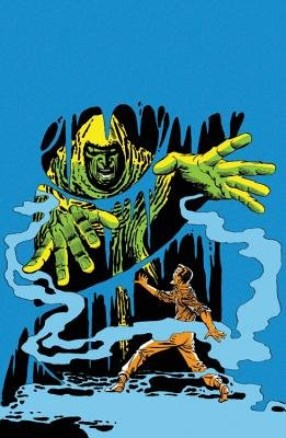Description
Before Stan Lee and Steve Ditko revolutionized comics heroes with Spider-Man and Doctor Strange, they applied their incomparable storytelling to taut suspense thrillers! Chilling stories cast with nervous-eyed dreamers and sweaty-palmed schemers, none of whom make it out without getting theirs. These parables of wrenching psychological tension, crafted by two of comics' most creative minds, will leave you curled up and screaming for more! Marvel is honored to collect Lee and Ditko's complete Silver Age stories of suspense in two beautifully restored Omnibus volumes - from Ditko's very first Marvel work in 1956 to his last five-page masterpiece! Collecting material from JOURNEY INTO MYSTERY (1952) #33, #38 and #50-73; STRANGE TALES (1951) #46, #50 and #67-91; TALES TO ASTONISH (1959) #1-26; TALES OF SUSPENSE (1959) #1-15 and #17-24; STRANGE WORLDS #1-5; WORLD OF FANTASY #16-19; AMAZING ADVENTURES (1961) #1-6; JOURNEY INTO UNKNOWN WORLDS #45 and #51; MYSTERY TALES #40, #45 and #47; TWO-GUN WESTERN (1956) #4; WORLD OF SUSPENSE #2; MARVEL TALES (1949) #147; SPELLBOUND (1952) #29; STRANGE TALES OF THE UNUSUAL #5; ASTONISHING #53; WORLD OF MYSTERY #3 and #6; BATTLE #63; and GUNSMOKE WESTERN #66.
About the Author
Writer/editor Stan Lee (1922-2018) made comic-book history together with Jack Kirby in 1961 with Fantastic Four #1. The monumental popularity of its new style inspired Lee to develop similarly themed characters — including the Hulk and X-Men with Kirby, Spider-Man and Doctor Strange with Steve Ditko, and Daredevil with Bill Everett. After shepherding his creations through dozens of issues — in some cases a hundred or more — Lee allowed other writers to take over, but he maintained steady editorial control. Eventually, he helped expand Marvel into a multimedia empire. In recent years, his frequent cameo appearances in Marvel’s films established Lee as one of the world’s most famous faces.
Born Jacob Kurtzberg in 1917 to Jewish-Austrian parents on New York’s Lower East Side, Jack Kirby came of age at the birth of the American comic book industry. Beginning his career during the rising tide of Nazism, Kirby and fellow artist Joe Simon created the patriotic hero Captain America. Cap’s exploits on the comic book page entertained millions of American readers at home and inspired U.S. troops fighting the enemy abroad. When World War II ended, the public’s interest in super heroes waned; Kirby turned his artistic talents during the 1950s to other genres, such as monsters, Westerns and crime — as well as the first-of-its-kind Young Romance Comics. In 1961, Kirby returned to super heroes to illustrate what would become the defining issue in Marvel Comics history: Fantastic Four #1. Written by Stan Lee, the team’s debut revolutionized the industry overnight. In contrast to the staid artwork of his predecessors, Kirby’s illustrations seemed to leap off the page with eye-popping action and drama. For the next decade, Kirby and Lee would introduce a mind-boggling array of new characters — including the Avengers, the Hulk, Thor, Iron Man, the Silver Surfer and the X-Men. Taken together, Kirby’s groundbreaking work with Lee formed the foundation of the Marvel Universe. In the early 1970s, Kirby moved to DC Comics, where his boundless creativity continued. He returned to Marvel in 1975, writing and illustrating Captain America and introducing his final major concept, the Eternals. With the explosion of TV animation during the 1980s, Kirby’s talents turned to the small screen. Comic fans quickly recognized his work on such series as Thundarr the Barbarian and Turbo Teen. Kirby died in 1994, but his influence on the comic book industry is as strong as ever. His work has inspired a generation of professional artists and modern writers who continue to explore his vast universe of concepts and characters.
